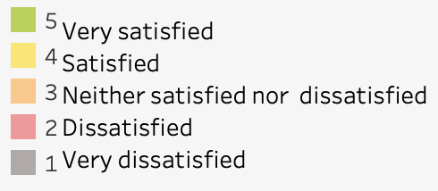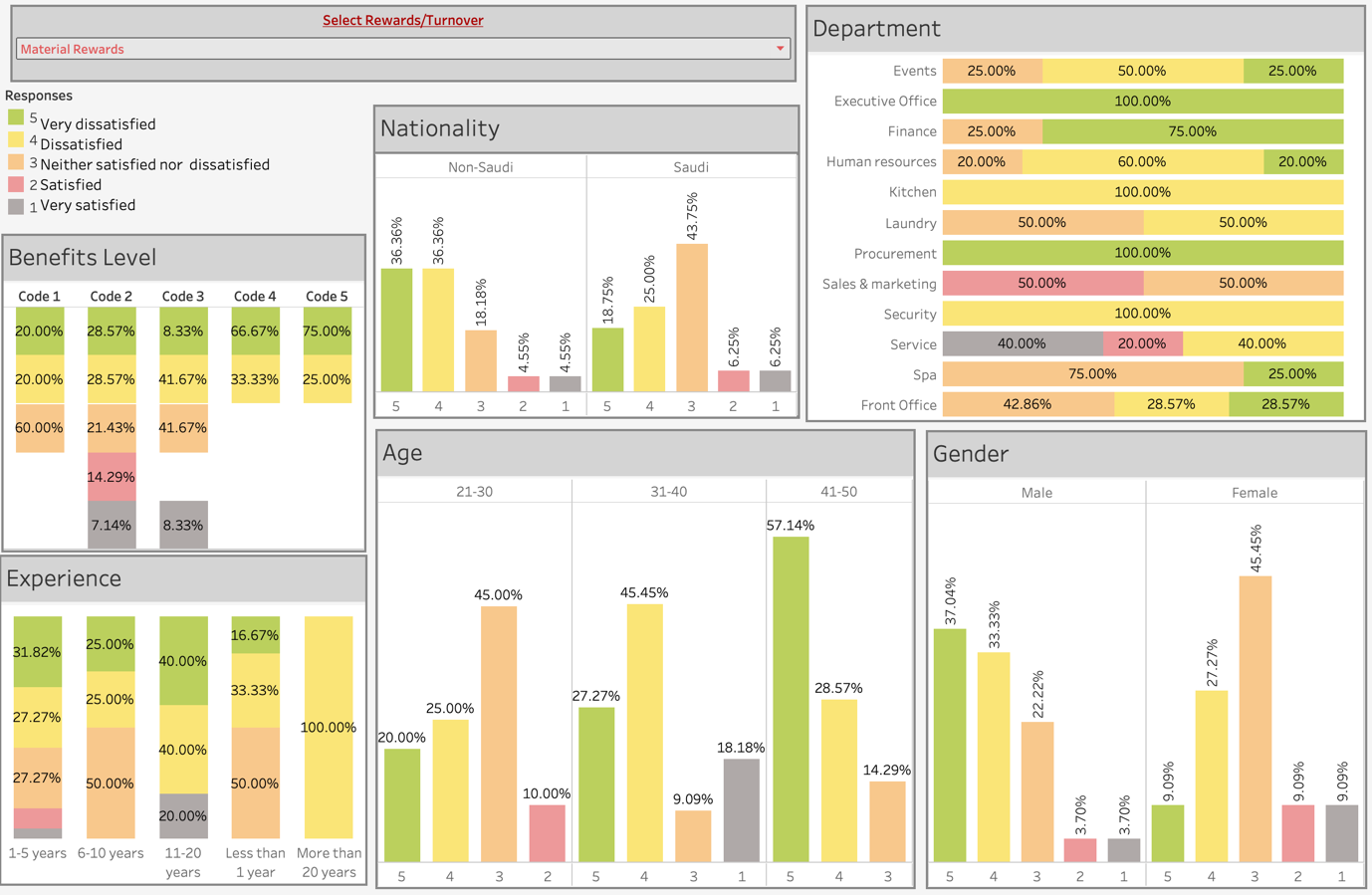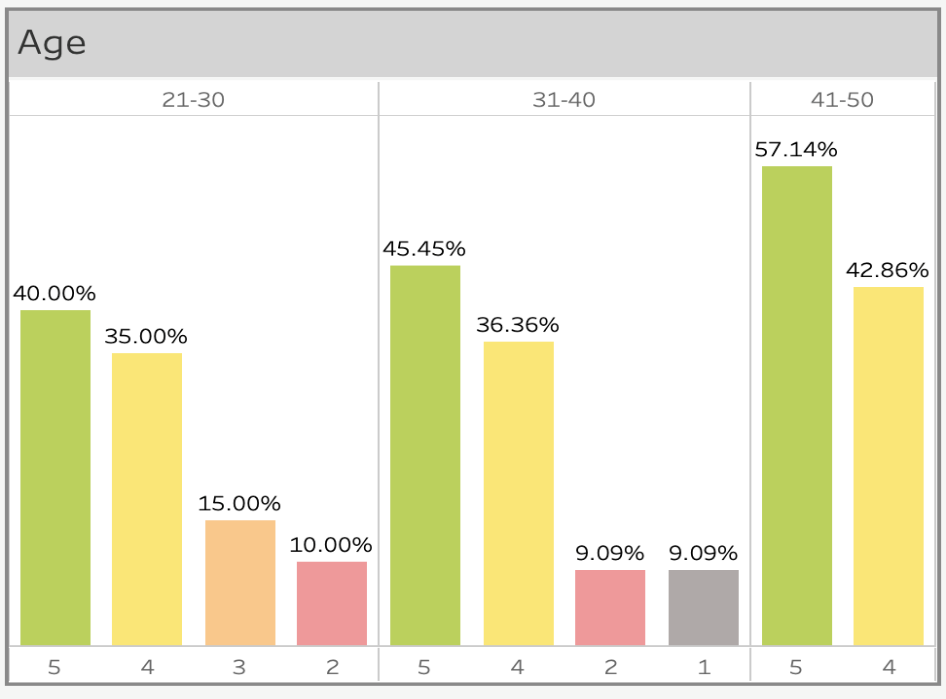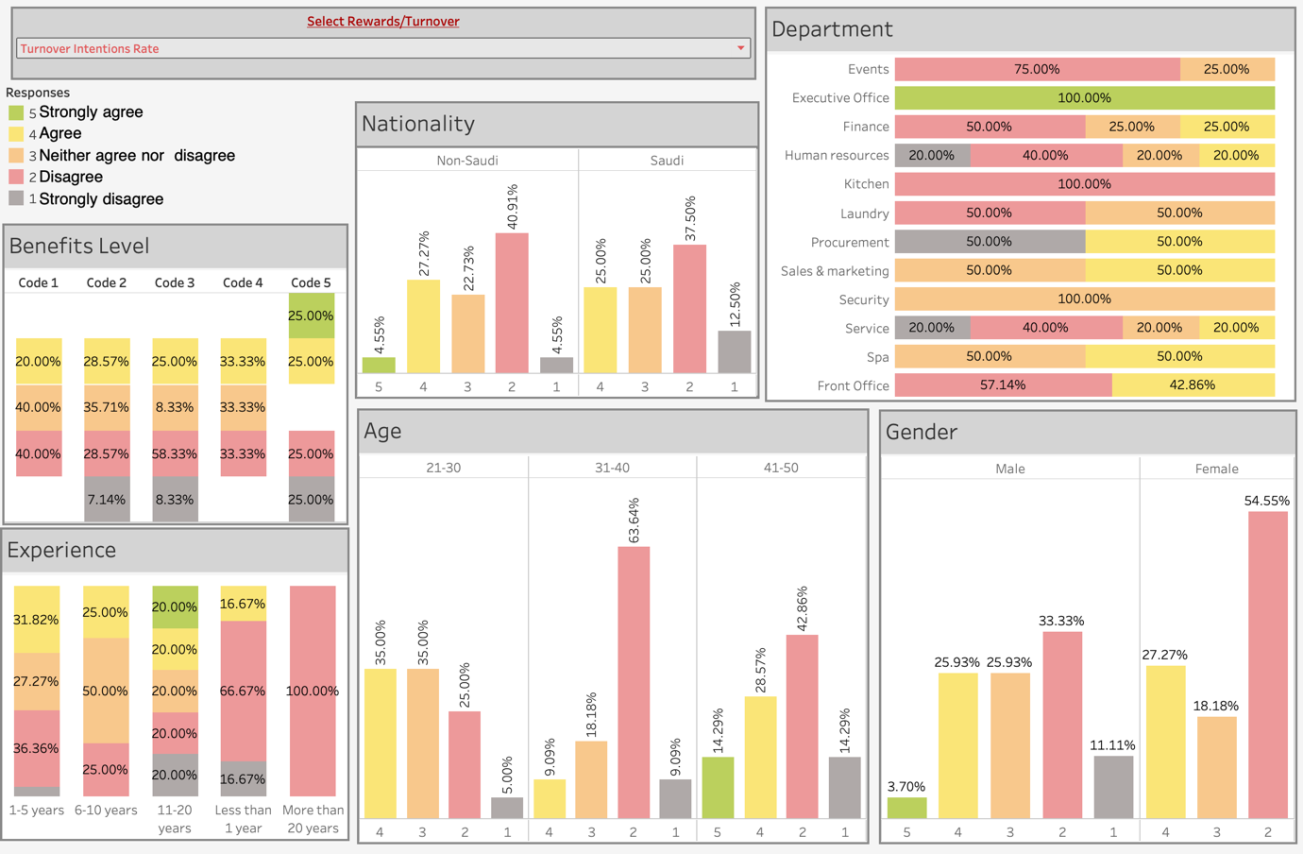Introduction
A survey was conducted to identify the interrelation between distinct factors, including financial rewards, material rewards, and psychological rewards, with job satisfaction levels. Another objective was to determine if satisfaction levels maintained by the above-mentioned factors influence workers’ turnover intentions. The survey considers age groups as the most significant aspect of data analysis. However, there are also some other considerations regarding several factors related to gender, nationality, experience, and department that may influence survey results. The chapter also focuses on assessing data quality using several methods such as a test of normality and the goodness of fit test. The final aim of data analysis is to identify the impact of different elements of rewards satisfaction on employees’ turnover intentions.
Data Quality
Data quality was evaluated by a variety of methods designed to test different aspects of collected data. First, case processing summary was introduced to assess data points’ validity and identify anomalies across the data set. Data points were proven to be valid, and no anomalies were found. Second, the Shapiro-Wilk test was conducted to test the null hypothesis (Nabou et al., 2021). Each variable was confirmed to have a p-value less than 0.05, meaning that the data is not normally distributed. As the dataset does not observe normality “Ordinal Logistic Regression” model was utilized to identify if question responses influence each other (Harrell, 2015). The interpretation has shown that the P-value is less than 0,05, and hence the independent variables considerably affect the model (Denham, 2017). Finally, the Goodness of Fit test was implemented in order to verify if the model suits the dataset (Nikulin & Chimitova, 2017). The Goodness of Fit test has shown a P-value greater than 0.05, which means that the collected data fits the chosen model (Fernández & Liu, 2016). Conclusively, even though different results occurred during testing, the data quality was proven to be sufficiently reliable.

The Satisfaction level of Financial Rewards in the Hyatt Regency Riyadh hotel
The satisfaction level of financial rewards depends significantly on a wide variety of factors. The survey determined that females are considerably less satisfied with financial rewards than males. Nationality aspects have shown that the majority of both Saudi and non-Saudi workers are satisfied. Department-related factors introduce inconsistent results, and it may not be possible to identify any specific tendencies. However, there is a noticeable difference in satisfaction rates related to age groups. Older people tend to be significantly more satisfied with financial rewards than younger age groups.


The Satisfaction level of Material Rewards in the Hyatt Regency Riyadh hotel
Material rewards satisfaction rates share a similar pattern with satisfaction levels of financial rewards. Nonetheless, there are some differences that should be taken into consideration. First, both men and women tend to be more satisfied with material rewards than financial rewards. However, males are more satisfied with material rewards than females. Second, even though there are smaller differences between age groups, older people show higher satisfaction rates related to material rewards. The service department also shows one of the lowest satisfaction levels with both material and financial rewards. Finally, non-Saudi workers are more satisfied with material rewards than Saudi employees.

The Satisfaction level of Psychological Rewards in the Hyatt Regency Riyadh hotel
Satisfaction levels of psychological rewards have some similarities with material and financial rewards. Nevertheless, females tend to be more satisfied with psychological rewards than males, which is the most striking difference. Both Non-Saudi and Saudi employees are highly satisfied with psychological rewards. Department-related factors share a similar pattern with high satisfaction among executive office workers and low satisfaction of service employees. The age group of 21-30 years tends to be the least satisfied with psychological rewards. However, the satisfaction levels are relatively high in general. Older employees between 41 and 50 years show very high satisfaction rates like previous results with financial and material rewards.


The Turnover Intentions Rate in the Hyatt Regency Riyadh hotel
Turnover intention rates may be influenced by different aspects, including job satisfaction rates, experience, age, and gender. First, females tend to be significantly less likely to have turnover intentions than males. Second, turnover intentions rates are relatively low regardless of nationality. Experience may influence turnover intentions rates significantly as all workers with more than twenty years of experience disagree with leaving or changing jobs. Most surprising results in terms of correlation between reward satisfaction and turnover intentions are related to department groups. Even though the service department shows minimal reward satisfaction, it also shows minimal turnover intentions. A similar discrepancy may be seen in the executive office department, which has the highest turnover intention levels despite high satisfaction. However, these contradictions may be related to analyzing a relatively small sample, and further analysis should be conducted (McNeish, 2016).

The Impact of Rewards satisfaction (Financial, Material, and Psychological) on employees Turnover Intentions in the Hyatt Regency Riyadh hotel
Statistical Package for the Social Sciences (SPSS) software was used to analyze collected data and assess the correlation between key factors comprehensively (Watkins, 2021). The Pseudo R-Square model has shown that approximately 82% of changes in turnover intentions are caused by financial, material, and psychological rewards. Such correlation may indicate that improving reward systems may be highly beneficial in terms of improving turnover intentions (Verma, 2015). However, it may be necessary to identify how individual factors influence the above-mentioned improvement. Therefore, parameter estimates were conducted, determining that financial and psychological rewards are the most significant. For every one unit increase in financial rewards and psychological rewards, there is a predicted increase of 0.569 and 0.848, respectively, in the log odds of being at a higher level of turnover intention rate (Ho, 2017). Psychological rewards may have the most impact on turnover rates, and hence it may be critical to focus on reward management. Conclusively, it is essential to introduce frameworks, which provide sufficient rewards to decrease turnover rates and related financial costs.
Conclusion
The main objectives of the data analysis chapter were accomplished by a comprehensive digital analysis of data obtained during the survey. First, several techniques were implemented in order to assess data quality. The sample dataset was proven to be reliable, and the chosen models were found to correspond with the data sample. Second, the data sample was analyzed in the context of diverse factors that may influence survey results. Age, gender, nationality, and experience were determined to have a substantial impact. Finally, digital methods and particularly SPSS software was utilized to evaluate the correlation between the existing system of rewards and turnover intentions among workers. The above-mentioned elements of the reward system were found to contribute to the decrease of turnover rates significantly. Therefore, it may be highly beneficial for the hotel industry to reconsider its approach to reward management (Akgunduz & Eryilmaz, 2018).
Reference List
Akgunduz, Y. & Eryilmaz, G., 2018. Does turnover intention mediate the effects of job insecurity and co-worker support on social loafing? International Journal of Hospitality Management, 68, pp.41–49.
Denham, B.E., 2017. Categorical statistics for communication research, Chichester, UK: John Wiley & Sons, Inc.
Fernández, D. & Liu, I., 2016. A goodness-of-fit test for the ordered stereotype model. Statistics in Medicine, 35(25), pp.4660–4696.
Harrell, F.E., 2015. Ordinal Logistic Regression. Regression Modeling Strategies, pp.311–325.
Ho, R., 2017. Introduction to SPSS. Understanding Statistics for the Social Sciences with IBM SPSS, pp.9–24.
McNeish, D., 2016. On Using Bayesian Methods to Address Small Sample Problems. Structural Equation Modeling: A Multidisciplinary Journal, 23(5), pp.750–773.
Nabou, A. et al., 2021. Shapiro-Wilk Test to Detect The Routing Attacks In MANET.
Nikulin, M.S. & Chimitova, E.V., 2017. Chi-squared goodness-of-fit tests for censored data, London: ISTE.
Verma, J.P., 2015. Data analysis in management with spss software, Springer.
Watkins, M.W., 2021. SPSS Software. A Step-by-Step Guide to Exploratory Factor Analysis with SPSS, pp.13–20.
